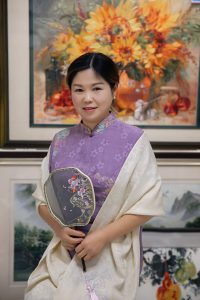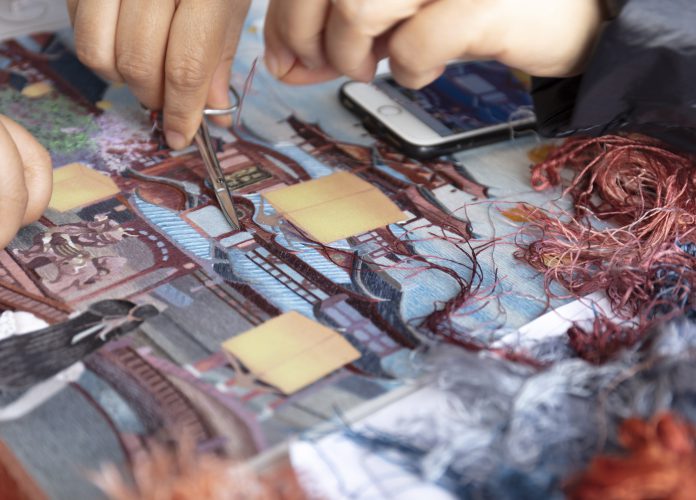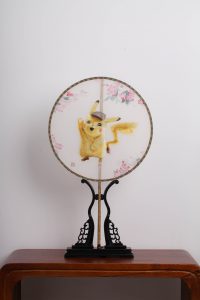Su Embroidery blends tradition with modern artistry
By Zora Yan
Embroidery master Zhang Xue combines traditional Su embroidery techniques with the image of Pikachu, a popular Japanese anime character, to create a folding fan.
Invited by the production team of the Japanese movie POKÉMON Detective Pikachu, Zhang then spent six months creating this handmade artwork featuring the cartoon character.
Zhang sent the folding fan as a gift to Ryan Rodney Reynolds, who did the voice of Pikachu in the film at a press conference when launching the movie in 2019.
“No one could have imagined that Su embroidery could be applied in this way,” the 36-year-old craftsman says.
Su embroidery refers to the sewing style in the Suzhou region, originating in the Chunqiu Dynasty. There are a total of four embroidery styles in China and the other three are Xiang from Hunan, Shu from Sichuan, and Yue from Guangzhou.
Zhang’s family has been engaged in Su embroidery for several generations. His journey as a craftsman began when he was four.
“My ideas differ from others as I don’t follow the traditional way of sewing paintings and patterns. I aspire to create modern Su embroideries such as the minimalist style featuring simplicity and a monochromatic palette of black and white that young people like,” he says.
In 2015, Zhang started his embroidery studio in Zhenghu, Suzhou. Unlike traditional embroidery artwork, which mostly features flowers and landscapes or follows specific patterns, he wants to do new inventions with Su embroidery.
“I am a big fan of ancient Chinese poetry and paintings, and I find inspiration from them. I also develop ideas from daily life elements like cloud shapes and TV programmes,” Zhang says.
Inspired by a TV programme about astronomy, Zhang created an artwork titled “Starry Sky” in 2016. He applied over 20 traditional needlework techniques that were on the verge of being lost to this modern artwork. The work is now being exhibited at the WorldSkills Museum in Shanghai, the first museum showcasing professional skills worldwide.
Zhang, who used to be a teacher at Suzhou Art & Design Technology Institute, has also become an inspiration for others.
“I have a male student in my class, and he told his parents about my embroidery. I was truly shocked when he successfully convinced his parents to let him choose Su embroidery,” he says.
He also observes an increasing interest in embroidery among young people.
“I think it’s good because more young people are keeping this cultural heritage alive, so it won’t disappear,” the master says.
With over 40 years of experience in Su embroidery, Xu Wenying, an arts and crafts master from Suzhou, also finds more young people learning embroidery at her studio.
“I used to think that young women nowadays are unwilling to learn Su embroidery and prefer working. I am surprised that many young people still want to create their own textile product,” Xu says.

Xu is now running Su embroidery courses for people to experience and learn the skill. Most are university students in their 20s and 30s.
The youngest student is a 12-year-old girl, Dai Ruiwen, who takes a four-hour high speed train ride from Tianjin to learn embroidery.
“I have always loved making my own handicrafts. I came across social media posts about Su embroidery when surfing online. I want to learn it,” Dai says.
She had a great sense of achievement after spending eight hours making the basic patterns of Su embroidery with the help of her master.
“I will continue learning Su embroidery in the future because I think it is a meaningful thing to do, and I hope I can help promote this culture in the future,” she says.
Xu’s son, Pu Hongtao, is running a social media account to promote his mother’s embroidery business.
“I am surprised that even primary school pupils are willing to travel from other cities to Suzhou to learn Su embroidery,” Pu says
Many young people born in the 1990s and 2000s from various parts of China have contacted Pu through his Chinese social media account on Xiaohongshu (Little Red Book) to come to Suzhou and learn Su embroidery from his mother.
“It is a wonderful thing to see so many young people becoming more interested in embroidery. Their dedication is impressive because not many young people nowadays are willing or able to engage in such time-consuming handicrafts patiently,” Pu adds.
Edited by Sean Pan
Sub-edited by Sunnie Wu








































